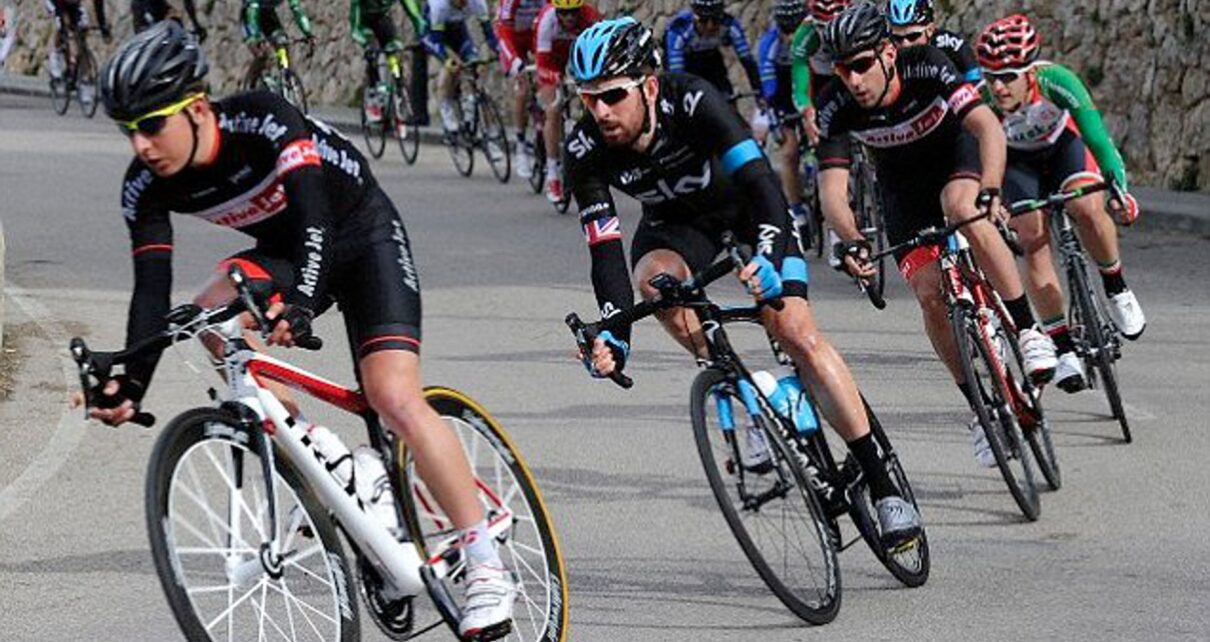For cyclists, it’s a drag when you don’t shave your legs.
- By Charles Digges

When I first gave up my running shoes for a road racing bike in 2016, I was confronted by a scroll of unspoken rules I would be expected to follow if I were to be taken seriously as a congregant in the Church of Cycling.
The edicts were compiled by the Velominati—an anonymous cycling cognoscenti that presents them as holy writ. Cycling shorts must always be black, though socks can be any color you like. The color of your saddle, however, must match the color of your handlebar tape and tires without exception. Which is to say, these, too, must always be black because tires only come in one color. And so it was for pre-ride coffees: black only, preferably espresso. Anything dulled by milk was purely for the unsaved.
Who was I to disagree? It was a demand of my new culture. I bought a razor and shaved my legs.
There were others. Never, under any circumstances, lift your bike over your head—it is undignified for the machine. If you are ever unfortunate enough to draw the number 13 at a race, it must be pinned to your jersey upside down. And speaking of bad luck, accidents are not to be spoken of unless they involved a visit to the emergency room. Road rash, scraped elbows, bruised hips, and other evidence of unexpectedly meeting the pavement are just part of the discipline.
Some rules were intuitive, like showing up for training rides on time because they start exactly when they are supposed to—and I have never known that not to be the case. Others were more bizarre, such as never putting a bike on a car’s roof rack unless the bike is worth more than the car—and you might be surprised at how often that is the case.
Helpfully, these rules were emailed to me by my first serious riding companion, a multi-time state champ who took his coffee black, drove a $19,000 Volkswagen, and dragged me for months along rural roads until I was strong enough to compete in our city’s weekend group rides.
Clearly, he told me, some of the rules are open to interpretation and convenience. But there is one that is not: Shave your legs.
There were no exceptions. Even the flamboyant Peter Sagan, then the world’s most revered cyclist, was once chastised by the elder brethren of the sport for having the nerve to turn up at a race au naturel.
Who was I to disagree? It was a demand of my new culture. I bought a razor and have been shaving my legs ever since.
As the summer tradition of the Tour de France once again descends upon us, a few hundred million devotees of the sport will watch, parse, argue about, and rejoice over the frenetic three-week-long procession that’s powered by some of the smoothest male legs on Earth.
But why, since the Tour began in 1903, have its participants shaved their legs? A matter of hygiene? An offering to the velo gods? Is it purely a question of peer pressure, guided by fear of wrath from the fussy deities on cycling’s Mount Olympus? Or is there something more earthbound behind it—some matter of utility that the great grandfathers of le ciclisme suspected long ago but couldn’t quite articulate as they first dragged a razor up their shins?
As it turns out, there is. Shaven legs are much, much faster. It just took until this century to prove it.
In 2012, as a recently minted graduate from the Massachusetts Institute of Technology, with a degree in mechanical engineering, Marc Cote came to Specialized, a dominant manufacturer of high-end bikes headquartered in California. Cote had a hypothesis: bicycle frames, wheels, helmets, jerseys, shorts, and shoes were all conspiring to cost elite cyclists valuable seconds in aerodynamic drag.
Aerodynamic drag, Cote explained to me in a recent chat, consists of two forces—air pressure drag and direct friction (known also as surface friction or skin friction). Direct friction is the force that occurs when wind meets the surface of rider and bike, but is nearly insignificant at the comparatively low speeds a cyclist travels. However, it is critical to consider when designing, say, an airplane.

GET A HAIRCUT: Laurent Fignon lost the 1989 Tour de France by eight seconds, the closest margin in Tour de France history. An experiment by Marc Cote, a mechanical engineer and cycling expert, showed Fignon would have won had he cut his drag-causing ponytail. Photo by Anders / Flickr.
On the bike, air pressure drag is the main beast. A cyclist and his machine form a blunt (“bluff” in aero lingo) shape forcing the air to separate around them as they move forward. The harder the cyclist pedals, the more the air in front of him is compressed, meaning that the harder he pushes forward to overcome this resistance, the harder the air pushes back.
Once the air grudgingly parts around the rider, the battle is not over. As the rider moves forward, battering the air out of the way, the air behind him becomes less dense, forming a low-pressure zone, or vacuum, that literally sucks him backward. This is a formidable force. In fact, on a flat road, aerodynamic drag is by far the biggest obstacle to a cyclist’s speed, accounting for 70 to 90 percent of the resistance felt when pedaling.
Reducing the surface area of the cyclist as he confronts the wind is therefore key. The more streamlined the design of an object, the easier it is for the air to close around it, thereby approaching the holy grail of aerodynamic design: laminar flow—that sublime moment when the air closes around a moving object without leaving a turbulent wake.
As there is little that can be done about the awkward shape of the human body—though it must be noted that most pro cyclists are tall and willowy and in constant battle with their weight—the design of the bike and the equipment the rider wears are critical to speed. The less that is flapping about in the wind, the smaller the surface area of cyclist and bike.
The Tour de France is one of the hardest tests of endurance that humanity has sadistically invented for itself.
This was an issue that the titans of yore hadn’t much considered as they pulled their baggy woolen jerseys over their heads. In the 1968 volume King of Sports: Cycle Road Racing, envisioned by its author as the final word on training, British cyclist Peter Ward argued for comfort over style. Clothing that is “the least bit tight or restrictive” should be avoided, he wrote. Cycling shorts, he added, should be held up with “braces,”—British for suspenders—and be “slack and comfortable.”
A few years later, in 1976, the Dutch pro cycling team TI–Raleigh ignored that advice and brought Lycra to the cycling mainstream. There hasn’t been a need for suspenders since. Over the following decades, the fit of cycling apparel has moved steadily skin-ward, cementing the image of the spandex-clad road warrior in the popular imagination. But Cote still suspected that there were a few wrinkles yet to iron out.
By 2013, he and his colleague Chris Yu in the aerodynamic research and development department had cajoled their bosses at Specialized into taking an enormous and cost-intensive leap—building a multimillion-dollar cycling-specific wind tunnel to track down and eliminate those last little bits of turbulence in the quest for a faster ride. The results were—and continue to be—transformative.
Research in cycling aerodynamics—what Cote calls “the invisible science”—has led to helmets that make the head of the wearer look like it has collided with a flying saucer, and shorts and jerseys that are so tight that it takes imagination not to see the more subtle curves of the flesh. The clunky shoes of Ward’s era have shed their laces for shrewder and smoother fasteners that don’t cause the air to hiccup around them. Even socks can be woven in special configurations that reduce drag. And new techniques in molding carbon fiber—the lightweight DNA of modern race bicycle-making—has produced frames that would have been unrecognizable as recently as 2007, when Lance Armstrong and his U.S. Postal team were still riding what amounted to a collection of fused-together cylinders.
Nonetheless, all the technological advantages can’t conquer the inevitable human bulk of the rider, who constitutes about 75 percent of the aerodynamic drag that cyclist-plus-bike must overcome. And that’s where Cote’s most surprising research comes in.
It began with Jesse Thomas, a Specialized-sponsored pro triathlete who dropped by Cote’s wind tunnel in 2014 to dial in his equipment before an upcoming Ironman competition. He, Cote, and Yu ran through different experiments—one comparing wheels, another tires, yet another helmets and skin suits—and chose those that the tunnel data said caused the least amount of drag. Ironman races include a 112-mile bike ride wedged between a 2.4-mile swim and a marathon, so any seconds Thomas could massage out of his equipment would be critical.
Thomas had turned up that day much the way Peter Sagan had at that race in 2016, sporting a full shag up his calves and thighs, though neither he nor Cote had put much stock in that until after completing the tests.
So as more of a gag than anything else, he and Cote thought they would solve the age-old riddle posed by the ancients once and for all: Does shaving your legs make any difference at all? Thomas sheared his guns to see.
The first set of results caused Cote’s jaw to drop. If the data were correct, Thomas could save 70 seconds for every 24.6 miles (or 40 kilometers, a standard time trial distance) he rode on the bike. This was an enormous time gain in a field of sports where victory is often decided by fractions of seconds and tenths of inches over a finish line.
So they tested Thomas again. And again. And the numbers kept showing the same thing.
It was a Eureka moment.








